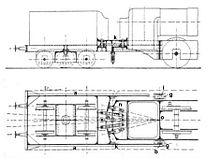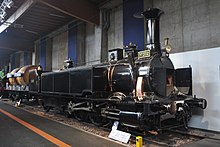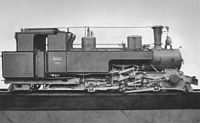Supporting tender locomotive

The support tender locomotive is a special design of the steam locomotive that arose from the requirement to support a fire box of a large, powerful boiler that overhangs far behind the last coupling axle . It represents a connection between a tender locomotive and a tank locomotive . While the water tank is usually mounted on both sides of the boiler like a tank locomotive , the coals are carried on the tender . The rotatable connection of the support tender to the locomotive creates a short, fixed wheelbase that allows the machine to move in curves. When the coal stocks stored on the support tender are removed, the coupling axles are less relieved than with a tank locomotive.
history
When the railroad conquered the mountains in the 1850s, the demands on the locomotives increased. The locomotives, which were getting bigger and stronger, could not be built with additional driving axles , because the curve had to be maintained. Therefore, the idea came up to allow part of the weight of the enlarged boiler to be absorbed by the tender while the fixed wheelbase was still small , which resulted in the support tender locomotives. The design proved itself at Semmering from 1853 , so that it was also put into service with other railways in Austria-Hungary, Switzerland, France, Spain and other countries.
Designs
With support tender locomotives, the correct allocation to tender and tender locomotives is difficult and is done differently for the various designs.
Engerth



In Engerth locomotives ranging Tender frame up to the firebox . The first tender axis is located in front of the fire box and supports it. A wide fire grate could also be built using a suitably designed tender frame . The connection between the locomotive and the support tender is made using a ball joint that is located in front of the first tender axis. In the Engerth design, the designation tank locomotive with an articulated frame is attached.
The first support- tender locomotives from Grünschacher to Sonnwendstein (top right picture) were built in 1853 by Wilhelm von Engerth for the Semmering Railway in Austria . They had three internally mounted, coupled axles and a two-axle tender, the two externally mounted axles of which were driven by gears. The gear drive of the tenders in the first locomotives did not prove itself, but the principle of the support tender locomotive did, so that the other machines were built without tender drive.
The Schweizerische Centralbahn (SCB), the United Swiss Railways and the Jura industriel had a large number of Engerth locomotives at times. The first series was delivered to SCB between 1854 and 1858 by Maschinenfabrik Esslingen 26 Ec 2/5 , of which the “Geneva” is still preserved as the oldest operational locomotive in Switzerland. The Bavarian State Railroad procured the doubly coupled BV PHOENIX and five triply coupled C II .
With the increase in traffic, the limited capacity of the water tanks next to the steam boiler had a negative impact. Because the adhesive weight decreased due to the water consumption , the pulling force decreased while driving. Another disadvantage was the limited space for the coal supplies on the support tender. The locomotive designs that emerged with the further technical development were on a par with the support tenders and so many Engerth locomotives were converted over time. The Austrian Southern Railway, for example, added a fourth laterally movable coupling axle to its first 26 support tender locomotives and replaced the support tender with a tender .
Engerth-Fink
Pius Fink was in the service of the StEG locomotive factory from 1859 . There he designed the StEG I 500–503 support tank locomotive , in which the tender axles were additionally driven by a jackshaft . Three of these locomotives, the “Steyerdorf”, the “Krahsova” and the “Gerliste” were used by the Austro-Hungarian State Railway Company from 1863 onwards . However, the design was not a lasting success.
Beugniot

In the design named after Édouard Beugniot , the tender only supports the overhanging part of the fire box to reduce the nodding of the locomotive or to take up a small portion of the locomotive's weight.
The mechanical engineering company André Koechlin , headed by Édouard Beugniot, supplied the Compagnie Paris-Lyon-Méditerranée in 1859 with two D3 'locomotives, "la rampe" and "la courbe". Two coupling axles each driven by inner cylinders via Hall cranks were connected to each other by horizontal double levers and ensured good cornering mobility. A design with external cylinders was used in Italy on the Giovi and Porrettana lines .
Behne-Kool
Locomotives with supporting tenders of the Behne-Kool design had a long firebox, also named after Behne-Kool, which hung over the back and in which inferior fuel could be burned on two grates lying one behind the other . To avoid overloading the rearmost axis of the locomotive, the fire box is supported on the tender. Since the tender frame continues almost to the middle of the fire box and there transfers part of the locomotive's weight to the first tender axle located under the fire box, Behne-Kool machines can be regarded as tank locomotives.
In Germany, support tender locomotives of this type were built between 1861 and 1872 by Egestorff in Hanover-Linden and Hanomag for the Braunschweigische Staatsbahn . These machines with the wheel arrangement B3 'and C3' had a Behne-Kool-fire rifle could be fired in the even carbon free and unfiltered pit coal. In Belgium, Behne-Kool locomotives were even more widespread under Alfred Belpaire .

cutter
Schneider in Creusot modified the basic form of Engerth for the construction of freight locomotives for the French Northern and Eastern Railways . He has retained the swivel joint between the locomotive frame and the supporting tender frame, which is located at Engerth between the last locomotive axle and the first tender axle in front of the fire box. However, he replaced the tender axle in front of the fire box with a locomotive axle and thus created a tender locomotive .
The same applies to the Klose and Krauss types described below:
Toilets
Adolf Klose had been studying the tender coupling since the early 1870s and built the B 2/3 for the United Swiss Railways in 1876 with a single-axle tender that moved around an ideal pivot point but did not support the rear end of the locomotive. The Klose type supporting tender with spring-loaded support for the rear end of the locomotive was used for the first time in the IIIa4 locomotives of the Bosna Railway, also built by Krauss-Linz . As with the Engerth locomotives, the pivot point of the support tender is in front of the fire box. In contrast, the first tender axle is not in front of, but behind the fire box.
The IIIa5 of the Bosnian-Herzegovinian State Railways (BHStB) built by Krauss in Linz from 1900 onwards was designed by Klose with a two-axle Krauss support tender.
Locomotives with Klose support tenders
The Saxon III K was largely identical to the Bosnian IIIa4 .
In contrast to the narrow-gauge support-tender locomotives, the standard-gauge kkStB 79, which was procured for the Arlbergbahn , proved less effective.
Krauss

After the support tender locomotives had lost their authorization on standard gauge , they came to a new bloom on narrow gauge . In the further development of Krauss , as it was carried out from the turn of the century, the rear end of the locomotive is supported as with Klose. However, the tensile forces are not transmitted via the tender side girders a (see picture on the right), but rather via an ordinary pull and butt coupling between the machine and the supporting tender. In order to save space and weight, the pivot d on the Klose machines has been replaced by the pulling device and two prism guides g attached to the side of the locomotive frame , in which the front ends of the tender longitudinal girders a are longitudinally displaceable in a ball pivot h . The mutual rotation of the locomotive and the support tender takes place around an ideal pivot point o , which is located at the intersection of the cross-connecting line of the ball studs h with the center line of the coupling bar k . In order to adapt to the rotation around this point, the coupling sleeves k and the tensioning buffers n of the support end coupling are directed towards o . The connection of the locomotive with the support tender is made in the transverse direction by the sliding pieces i and in the longitudinal direction by the coupling.
Support tender locomotives of the types Klose and Krauss were used in particular on narrow-gauge railways with many tight curves. They allowed the construction of curved steam locomotives with large heating and grate surfaces .
Locomotives with Krauss support tenders
Krauss equipped the for Mariazellerbahn developed series Mh in Bosnian gauge of the proprietary Supports Ender.
The meter-gauge locomotives built by Krauss and Maffei proved their worth in northern Spain. Machine number 17 on the Ponferrada –Villablino line.
Krauss supporting tender of a JDŽ 186 (originally IIIa5 of the BHStB) with 760 mm gauge of the Yugoslav State Railways.
swell
- Georg Lotter: The locomotives and steam cars at the Bavarian anniversary state exhibition in Nuremberg in 1906. Historical review of the development of the supporting tender locomotive . In: The Locomotive . Illustrated monthly magazine for railway technicians. Year 1906, issue 7, page 110ff. ( ANNO historical Austrian newspapers and magazines)
- Victor von Röll : Encyclopedia of the Railway System. Locomotive. Second, completely revised edition 1912–1923 in 10 volumes, Urban & Schwarzenberg Verlag, Berlin / Vienna. Digitized edition at Zeno.org
- Raimar Lehmann: Steam locomotive special designs . Springer, Basel, ISBN 978-3-0348-6757-3 .
Notes and individual references
- ↑ On the development of the steam locomotive in Switzerland. In: Schweizerische Bauzeitung (SBZ), Volume 86 (1925), Issue 13. (archived in E-Periodica of the ETH Library. PDF, 8.8 MB)
- ↑ a b 3/4 joint. Composite tank locomotive with 1 m gauge of the Innsbruck-Igls local railway . In: The Locomotive . Illustrated monthly magazine for railway technicians. Year 1906, issue 5, page 87f. ( ANNO historical Austrian newspapers and magazines)
- ↑ a b c d according to Röll: Encyclopedia of the Railway System. locomotive
- ^ G. Scheingraber: Locomotives and wagons of the Royal Bavarian State Railways . In: Deutsche Eisenbahnen - Type sketches and sections . tape 3 . Franckh'sche Verlagshandlung, Stuttgart 1968, p. 2 .
- ↑ Hilscher: The locomotives of the former Austrian state railways in the 40s and 50s of the last century. ( Page no longer available , search in web archives ) Info: The link was automatically marked as defective. Please check the link according to the instructions and then remove this notice. In: The Locomotive . Illustrated monthly magazine for railway technicians. Year 1922, issue 8, page 112. ( ANNO Historical Austrian newspapers and magazines)
- ^ Alfred Moser: The steam operation of the Swiss railways 1847-1966 . Birkhäuser Verlag Basel and Stuttgart 1967, page 86f
- ^ Victor von Röll: Encyclopedia of the Railway System. Behne-u.-Kool locomotive. Digitized edition at Zeno.org
- ↑ German Reich Patent Office No. 160.755
- ↑ The Locomotive, 1906, p. 112
- ↑ see Lotter: The Locomotives and Steam Cars at the Bavarian Anniversary State Exhibition in Nuremberg in 1906. Historical review of the development of the supporting tender locomotive













